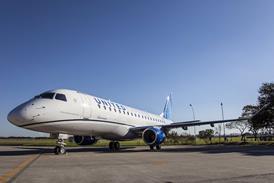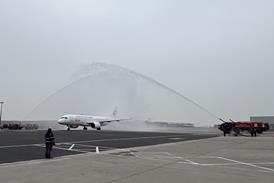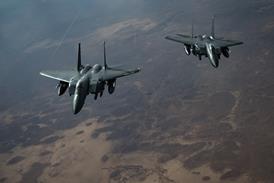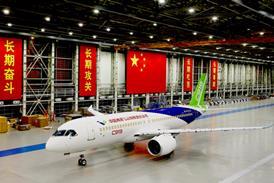With the population of very light jets expanding rapidly in Europe, Eurocontrol is extending its efforts to prepare for their impact on European airspace. The urgent need to address the challenge arises not only from the sheer numbers anticipated, but because of the effect their different performance could have on upper airspace and terminal manoeuvring area (TMA) traffic flow.
On-board systems approved for VLJs in US airspace are not necessarily going to be enough in Europe, because traffic density is higher, and it has less airspace suitable for operating under visual flight rules. DayJet in the USA, for example, strives to operate under VFR whenever possible and achieves it much of the time. In Europe that would be almost impossible.
 |
|---|
© London Executive Avation |
Europe is working hard to determine what the air traffic management system will have to do to cope with the demands VLJs will pose, according to Eurocontrol's deputy director of air traffic management strategies Alex Hendriks. In fact, he reveals, the US Federal Aviation Administration - which originally did not study the emergence of VLJs as a separate phenomenon from the ATM point of view - has been sufficiently impressed with Europe's brainstorming and research on the issue to invite the European ATM agency to Washington DC in September to share ideas on how to meet this new challenge.
Crunching The Numbers
About 500 VLJs are on order from European customers and nearly half of these are expected to be delivered by the end of 2010, says Eurocontrol. It estimates that 100 aircraft will enter service each year and 700 will be operating by 2015. Eurocontrol's latest research indicates that the average VLJ in Europe - mostly in the hands of air taxi operators - will operate three flights of about 1h duration each day, says Hendriks. Each year, Eurocontrol sees the ATM system having to handle a net additional 200-300 flights a day just because of the introduction of VLJs into Europe's airspace.
UK-based London Executive Aviation (LEA) managing director George Guanopoulous, whose business jet charter organisation began operating Cessna Citation Mustang VLJs in February and will be flying five by the end of May, says the average trip so far seems to be about 90min, the aircraft do about 2.5 sectors a day, and the flight profile normally takes the aircraft to a cruising level between flight level 290 (29,000ft/8,840m) and FL350. Longer trips, Guanopoulous says, have taken the LEA Mustangs to FL390 and once to the aircraft's FL410 ceiling. Unlike DayJet, says Guanopoulous, LEA assumes all flights will be under instrument flight rules because, at the altitudes it uses, in Europe there is no alternative.
All the LEA Mustang fleet are fitted with a simple airborne collision avoidance system (ACAS), but not the more advanced TCAS II system that airlines are required to carry. Guanopoulous says TCAS I is offered by Cessna as an option, and LEA specified it. TCAS 1 provides the crew with a display showing the relative position and height of nearby aircraft, but it does not provide resolution advisories - the manoeuvring alerts that TCAS II generates.
Eurocontrol Forum
Meanwhile, Eurocontrol has set up a forum, the European VLJs Integration Platform, which aims to bring together VLJ manufacturers and operators to discuss mechanisms and strategies to integrate the jets into the European ATM system. Eurocontrol also intends to use this forum to collate enough accurate information about VLJ performance and the types of operation owners anticipate carrying out to enable the agency to set up an ATM simulation to examine the effects of VLJ proliferation.
Starting in October, the simulation will be mounted at Eurocontrol's research centre in Budapest, Hungary, says Hendriks. It will be a vital tool in determining how best to handle this new air transport phenomenon, which should not be underestimated, he says. "The growth of VLJs adds a significant extra dimension to the complexity of air traffic in Europe," he adds.
He says the different performance characteristics of VLJs compared with regular commercial aircraft, both in the departure and en-route phases of flight, are likely to have a "considerable impact" on the air transport network. As a result, ideas that are already being developed for testing in simulation include separate VLJ departure paths from busy airports and tactical track offsets from busy routes.
Several types of VLJ are already available or in the final stages of development. Among them are the Mustang, the Eclipse 500 and the Embraer Phenom 100.
 |
|---|
© Embraer |
These VLJs have the potential to create problems if the operators choose to cruise between flight levels 330 and 350 - the most heavily airline-populated altitude band in European airspace - but will travel at speeds of only 340-380kt (630-700km/h), about 20% slower than larger transports.
There are also concerns over the lower climb rates of VLJs compared with those of jet airliners and high-performance business jets. Eurocontrol's airspace network planning chief, Joe Sultana, told a VLJ workshop last year that aircraft performance differences, in both en-route and terminal airspace, could lead to a significant impact on controller workload.
He also warned that wake vortices could pose a hazard to VLJs that need to climb or descend through occupied flight levels, because their particularly light weight, and their low rates of climb and descent at those flight levels, makes them even more vulnerable than heavier, higher-performance business jets.
Possible strategies to cope with VLJs could include airspace redesign, with dedicated departure and arrival patterns, as well as parallel offset procedures.
From next year, VLJs could be contributing an additional 200-300 flights a day to European traffic and this figure is expected to reach 1,000 flights a day by the middle of the next decade. "We'll also need to assess the technical requirements for on-board systems," says Hendriks.
This will include an analysis of whether VLJs should be required to carry an ACAS. European airspace regulations only mandate carriage of such systems by civil aircraft with a maximum take-off weight of over 5,700kg (12,550lb) - twice that of a typical VLJ - or with more than 19 seats. But that rule was made in an era when most aircraft below that weight band would have been turboprops or piston-powered aircraft, which would naturally occupy flight levels below flight level 290 (29,000ft/8,840m) - usually well below it.
Eclipse president Vern Raburn insists that ACAS - in the form of TCAS II, which is the European requirement - is an overrated asset. He has some emphatic observations on it: "There is a reasonable amount of stupidity surrounding TCAS II. There is analytical data to show the more congested the skies the more likely it is to fail. The effectiveness of resolution advisories is overrated and based on the bleating of a lot of people. The only reason aircraft crash is because pilots screw up. Putting bells and whistles on board doesn't make it better."
He adds that there is a physical problem for the Eclipse 500: "It does not have the surface area to add an antenna without a massive and expensive development effort. Antenna technology has not advanced that much. Based on our analysis of all technologies, going forward with TCAS II would be a big mistake."
Raburn, along with others in the industry, would rather rely on an automatic dependent surveillance - broadcast (ADS-B)-based separation assurance system, but neither Europe or the USA seems to be ready for that yet. Eurocontrol's Hendriks remarks that few aircraft in Europe are ADS-B equipped. Although the USA is further ahead in ADS-B equipage than Europe, it is still not an FAA-approved separation safety net system in passenger aircraft - TCAS II is.
Eurocontrol also says there "may be difficulties in adapting certain VLJs' avionics systems to comply with particular navigation requirements". These include a requirement for Mode S transponders to be fitted as standard, and more precise navigational performance despite the lack - at present - of a Europe-wide area augmentation system for satellite navigation, which will entail equipping Europe-based aircraft with more ground-based navigation system receivers than would be required in the USA.
Hendriks says that, although the VLJs have the capability to operate at airline cruise altitudes, most operators' flight profiles will probably not demand that. He also anticipates that, when possible, VLJ operators - particularly owner/pilots - will try to operate VFR in uncontrolled airspace to avoid user fees.
Meanwhile, he is confident that ways and means can be found to cope with the additional traffic movements VLJ marketplace success will inevitably bring.
European Certification Considerations
New very light jets and business jets in Europe will be subject to a basic level of certification, plus requirements tailored to the aircraft's performance, says the European Aviation Safety Agency.
Aircraft like the Eclipse 500 VLJ twinjet, which is in a market sector close to that now occupied by twin-turboprop aircraft like the Beechcraft King Air series, has a cruising altitude capability and avionics fit that differentiates it dramatically from the latter, introducing additional certification considerations, says Paul Hatton, EASA's project certification manager, general aviation. He does not put a date on expected Eclipse 500 European certification, but Eclipse president Vern Raburn hopes for the third quarter of this year.
 |
|---|
© Eclipse |
EASA says although it works closely with the US Federal Aviation Administration on certification and airworthiness issues, there may be a few differences between them on VLJ requirements reflecting the more congested European operating environment. As for aircraft like the Eclipse 500 that are certificated to fly as high as flight level 410 (41,000ft/12,500m), Hatton points out that consideration must be given to the time taken to lose altitude in the event of sudden loss of cabin pressure, especially since the aircraft does not have spoilers.
Other considerations include the requirement for sufficient back-up electrical power for the sophisticated integrated avionics fit. Hatton also points out that extensive avionics integration also introduces the need for tougher checks on software and hardware integrity than would be required for systems comprised of independent instruments, although he does not foresee a need for different standby instruments than those normally provided.
Using the Eclipse 500 as an example of the considerations EASA has to take into account, Hatton says there will be no difference in the basic aircraft specification between those purchased by owner-pilots for personal use and those used for air taxi operations. But there will be more-stringent performance standards required of air taxi operators, with higher margins required for take-off and landing distances, including increasing the margins involved in calculating corrections for contaminated runways, to guarantee the safety standards that passengers should be able to expect from commercial operators.
Hatton explains there are generic principles EASA has to take into account in deciding how to regulate the new generation of light jets. For example, when a propeller-driven aircraft goes wrong, he says, it is more likely than a jet to be flying at a low altitude and to be operating under visual flight rules.
Conversely, if a jet gets into trouble it is more likely to be at higher altitude than a propeller-driven aircraft and to be operating under instrument flight rules. These considerations change the risk management equations that have to be considered in rulemaking. So even for the owner-flown VLJ, says Hatton, "you have to apply rules beyond those applied to a Cessna 172". EASA has a duty of care not only to owner-pilots, says Hatton, but to their families and friends who will fly with them, assuming a high level of safety in what looks like a sophisticated aircraft.
Source: Flight International























